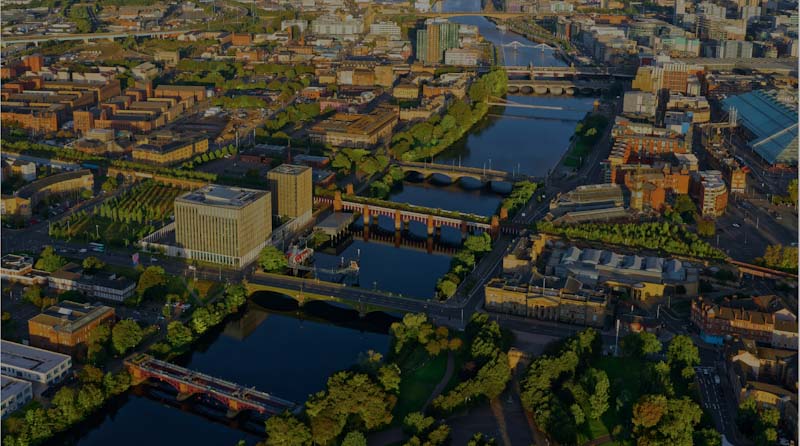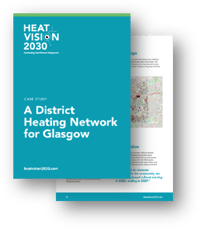Deploying district heat networking has been identified by authorities across the U.K as one of the key factors in meeting carbon neutral targets. If we were to deploy a heat network in the city centre of Glasgow, we can replace 140GWh of fossil fuel heating every year, which will displace 31.5 kilo tonnes of CO2, resulting in zero-carbon heat for 60 years. The Heat Vision 2030 project has estimated that this would cost around £250 million to make happen.
Other examples that have crossed our desk recently include Chelmsford, Medway, Worthing, Solihull, Barking, and Bridgend. You can add any large city in the country to the list and you will find that hundreds of millions of pounds are being assigned to developing heat networks.
Interestingly though, the size and scale of these heat networks do not really match up with the stated goals. 90% of heat networks being funded today in the U.K. have a total CapEx of less than £20 million and there is perhaps a handful with budgets that approach £100 million. With these budget limitations, it is all the more important that the design phase is as accurate as possible so that deployments stay within the allocated budget.
'The planning and design phase not only has to consider the needs of today but also be ready for the needs of the future.'
The good thing is that heat networks if planned correctly, can be expanded. A project that focuses on 50 public buildings today can be designed and developed to incorporate thousands of buildings of all kinds over the course of time. With careful planning, the whole of Glasgow City center could be heated by a low carbon heat network within 10 or 15 years.
But how can we plan for a zero-carbon heat network?
We need to begin by imagining them. We need to visualize and play with the size of the prize. We need to challenge our preconceptions and be curious about the possibilities. We need to explore and we need to be ambitious.
We also need to be realistic. We need to start incorporating data and information to start building models so we can understand the possibilities that are available to us. We need to start developing scenarios that we can share and that can be used as a platform for collaboration.
Learn about the three levels of district energy network design maturity to deliver high-quality techno-economic feasibility research essential for energy transition plans.
This is where network design software, such as Comsof Heat, comes in.
Comsof Heat is a heat network mapping tool that follows the Heat Network Development Unit (HNDU) and the Royal Institute of British Architects (RIBA) design and development process. Comsof Heat is applicable from the heat mapping and master planning stage through to detailed project development.
The software works at any scale from dozens to thousands of buildings and it does this based on real data. The results are multiple realistic scenarios that can be calculated and visualized in a workshop setting. These scenarios can be compared against different feasibility, planning, and finance criteria at the same time.
In addition, Comsof Heat can create these scenarios in a short amount of time, and with more accuracy than a team of designers manually designing the network. The software requires fewer man-hours to provide more detailed scenarios that are easier to scrutinize and improve. As such Development, Technical and Executive teams can collaborate on developing scenarios and compare different, detailed energy strategies.
Heat Vision 2030: A District heating network for Glasgow
Change can happen and budgets can be met if the planning is solid. With software such as Comsof Heat the planning and design stages for heat network deployment can be rapid and as cost-effective as possible, so we can meet our 2030 target.
The study on Glasgow's District Heating Network delves into the obstacles faced in terms of financial investment, stakeholder support, and disruptive construction. The utilization of computational power, specifically through the use of Comsof Heat, is pivotal in the intricate design and planning of the network.
Download the full white paper >>>
DESNZ has issued a tender for Heat Network Zoning and IQGeo can support any consultancy with Comsof Heat.
The approach with Comsof Heat offers significant advantages in the development and optimization of the initial zoning opportunity's (IZO’s). Using Comsof Heat enables consultancies to provide a consistent level of detail, accuracy, and quality output over all IZO’s, underpinning DESNZ requirement to implement a standardized heat network zoning methodology. Using an automated routing, dimensioning and planning tool enables an integrated solution where the geospatial model, the technical model and the financial model are tightly interconnected, integrated within a GIS application. Doing so enables a consistent and precise estimation of the required heat capacity and distribution infrastructure, minimizing the risk of overinvestment or underestimation.
Contact Kurt Marlein to discuss partnering with IQGeo and utilizing Comsof Heat for the UK Heat Network Zoning project.
Author Bio
Ben Carter is an expert in city-wide district heating solutions, energy strategy & market development, with specialist knowledge of heat networks, renewable energy, and energy efficiency.



 Previous
Previous



